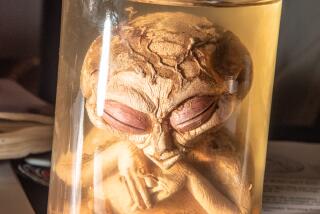Book Review : Of Faith and Comets: An Inside Look
- Share via
The Nemesis Affair: A Story of the Death of Dinosaurs and the Ways of Science by David M. Raup (Norton: $14.95)
How do we know what we know? It is a question that has intrigued philosophers since the Greeks. And, as with all such questions, the answer is no more certain today than it was when Socrates took a crack at it.
Since the Renaissance, the Western world has put great faith in reason and the scientific method as the right way to know things. This has proved very effective--in scientific matters at least--and we now accept as a given that reason is the way to knowledge, though it is still an open question whether it is the only way or even the most important way.
A Shaky Proof
Why should there be a correspondence between the thinking processes in our brains and the order of the universe? Unfortunately, the only means we have to address this question is reason, a circularity that makes the proof suspect.
In any case, reason is the tool we rely on in many areas of human affairs, science paramount among them. In recent years, the world has discovered that even science--the paradigm of reason--contains a healthy dollop of belief, prejudice and emotion.
When scientists decide what the truth is at any given moment, there is more going on than experiments and appeals to reason. The models of science developed by Karl Popper and Thomas Kuhn may not take sufficient account of the role of non-reason in the development and assessment of scientific theories.
David M. Raup, a University of Chicago paleontologist, is a principal player in a recent, well-publicized scientific idea, namely that the dinosaurs died out 65 million years ago during a periodic mass extinction caused by the Earth’s colliding with a comet.
To back up: What happened to the dinosaurs is one of those puzzling scientific questions that have never been satisfactorily answered. They lived for 140 million years and then died out suddenly. Changing climate or a rising (or falling) sea level is the generally accepted answer, but both explanations leave a lot unanswered.
Since 1980, a lot of work has been done in geology, paleontology, astronomy and astrophysics on the idea that the dinosaurs died out after a huge comet struck the Earth, kicking up dust, debris and fire ash that darkened the sky for months, killing plants and the animals that ate them, a non-nuclear winter.
This idea has been expanded into the notion that these extinction events occur periodically, such as every 26 million years or so, and they are occasioned by an extraterrestrial event. In the most familiar version of this scenario, the event presupposes the existence of a companion star to the sun, called Nemesis, which passes through the Oort Cloud of comets out beyond Pluto, sending them showering in toward the Sun where one or more of them strike the Earth, sending up the dust cloud, etc.
Extinctions Not Random
Raup’s contribution to this hypothesis is the discovery, with Jack Sepkoski, that the fossil record indicates that extinctions of species were not randomly spaced but were bunched every 26 million years for the last 250 million years.
This finding remains controversial. The debate over it requires advanced statistical techniques and is therefore not accessible to most of us. Raup leaves it at that, acknowledging that there are still debates over the interpretation of the data.
Raup’s book is an insider’s look at the sociology of a scientific hypothesis, how an idea starts, develops, is tested, gains adherents and sparks new work. The extinction of the dinosaurs has been a hot topic for the last few years, and it has been reported on extensively in the popular press. Raup tells the story of how the scientists went about it, where they adhered to the scientific method as taught in textbooks, and where other factors were involved.
Though he is a clear partisan for the extinction hypothesis, Raup even-handedly assesses the evidence and arguments for and against it.
In short, there is not a shred of evidence to support the idea that a periodic comet shower has caused periodic mass extinctions throughout geological time. In fact, there isn’t even any evidence that the Oort Cloud of comets exists. No one has ever seen it.
Possible, But Unlikely
Nor can the hypothesis of periodic extinctions be disproved. It is an appealing conjecture that has neither been proved nor disproved, which is hardly enough to be deemed as fact. Raup concedes that most scientists think of the hypothesis as technically possible but unlikely.
So this book is a good review of the periodic-extinction hypothesis and an admirable description of the way scientists think and science works. A minor quibble is that Raup doesn’t say enough about the personal aspects of research. Scientists are driven by passions just as everyone else is, but there isn’t much evidence of them here.
The book is more than a description of a scientific debate and a primer on the scientific method in action. It goes beyond those problems to the fundamental questions of how we know what we know. Raup recalls that when he first read Walter Alvarez’s paper in 1980 proposing that a collision with a comet led to the extinction of the dinosaurs, he was against it. After his own work turned up periodicity in the record of extinction, Raup reread the Alvarez paper and found it convincing. He wonders how much prior belief is essential to accepting a new idea, and he demonstrates that science rests as much on belief as any religion does.
At any time, there is a conventional wisdom in science that has become accepted almost without further question, and any challenge to it meets heavy suspicion. The more revolutionary the new idea, the greater the suspicion, so that really revolutionary ideas are considered crackpot and don’t get a hearing at all.
What he overlooks is that the Nemesis theory has been getting a fair scientific hearing, and the trouble with it so far is that there is no evidence to support it. As more and more constraints have to be added to a theory, it begins to look like Ptolemy’s universe, with the Earth in the center and the planets going around in ever-more-complicated orbits. If someone had some supporting data, the Nemesis theory would be more convincing.
But Raup’s story is challenging and thought provoking. How much of what we are sure of do we simply believe in?
Most, probably.


